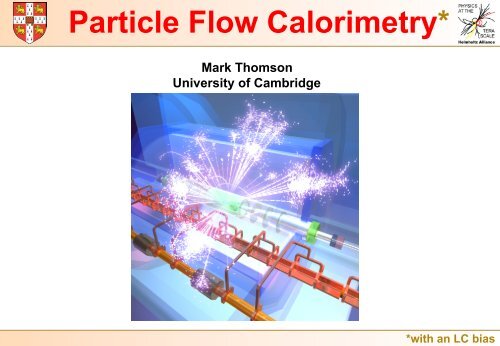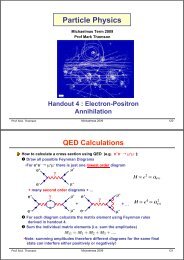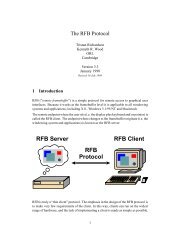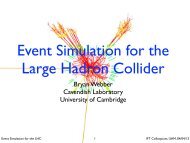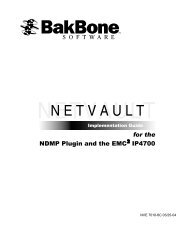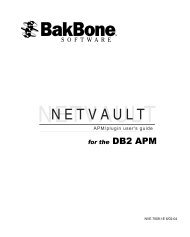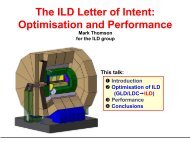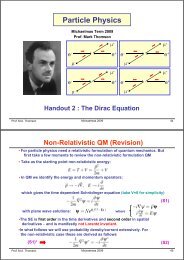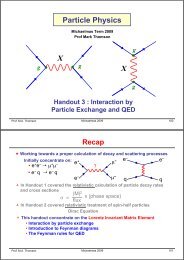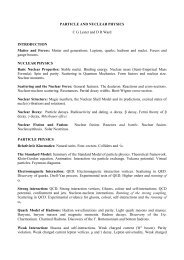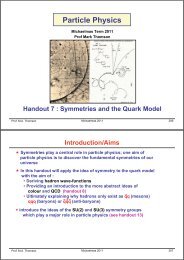Particle Flow Calorimetry* - High Energy Physics Group - University ...
Particle Flow Calorimetry* - High Energy Physics Group - University ...
Particle Flow Calorimetry* - High Energy Physics Group - University ...
Create successful ePaper yourself
Turn your PDF publications into a flip-book with our unique Google optimized e-Paper software.
*with an LC bias<br />
<strong>Particle</strong> <strong>Flow</strong> <strong>Calorimetry*</strong><br />
Mark Thomson<br />
<strong>University</strong> of Cambridge
Outline<br />
This talk:<br />
1) What is <strong>Particle</strong> <strong>Flow</strong> Calorimetry ?<br />
2) Calorimetry Goals at the ILC<br />
3) Linear Collider Detector Concepts<br />
4) <strong>Particle</strong> <strong>Flow</strong> Reconstruction<br />
5) <strong>Particle</strong> <strong>Flow</strong> Performance<br />
6) Beyond <strong>Particle</strong> <strong>Flow</strong><br />
7) Summary<br />
Mainz, February 2013<br />
Mark Thomson<br />
1/27
1) What is <strong>Particle</strong><br />
<strong>Flow</strong>?<br />
Mainz, February 2013 Mark Thomson 2/27
What is <strong>Particle</strong> <strong>Flow</strong> ?<br />
« No strict definition of particle flow calorimetry…<br />
§ Move away from pure calorimetry<br />
§ Move towards full event reconstruction<br />
• Use tracks to correct/determine jet energies<br />
« Used in three main contexts:<br />
§ “<strong>Energy</strong> flow”<br />
• Use tracks to correct jet energies<br />
§ “<strong>Particle</strong> flow/Full event reconstruction” e.g. CMS<br />
• Aim to reconstruct particles not just energy deposits<br />
§ “<strong>High</strong> granularity particle flow” e.g. ILC<br />
• Technique applied to detector concept optimised<br />
for particle flow<br />
Mainz, February 2013 Mark Thomson 2/27
Traditional Calorimetry<br />
« In a typical jet :<br />
s 60 % of jet energy in charged hadrons<br />
s 30 % in photons (mainly from )<br />
s 10 % in neutral hadrons (mainly and )<br />
« Traditional calorimetric approach:<br />
s Measure all components of jet energy in ECAL/HCAL !<br />
s ~70 % of energy measured in HCAL:<br />
s Intrinsically “poor” HCAL resolution limits jet energy resolution<br />
π +<br />
γ <br />
n<br />
<strong>High</strong> quality tracking<br />
information not used<br />
E JET = E ECAL + E HCAL<br />
Mainz, February 2013 Mark Thomson<br />
3/27
<strong>Particle</strong> <strong>Flow</strong> Paradigm<br />
« <strong>Particle</strong> flow approach:<br />
s Try and measure energies of individual particles<br />
s Reduce dependence on intrinsically “poor” HCAL resolution<br />
« Idealised <strong>Particle</strong> <strong>Flow</strong> Calorimetry paradigm:<br />
s charged particles measured in tracker (essentially perfectly)<br />
s Photons in ECAL<br />
s Neutral hadrons (and ONLY neutral hadrons) in HCAL<br />
s Only 10 % of jet energy from HCAL improved jet energy resolution<br />
π +<br />
γ <br />
n<br />
E JET = E ECAL + E HCAL<br />
E JET = E TRACK + E γ + E n<br />
Mainz, February 2013<br />
Mark Thomson<br />
4/27
Realising <strong>Particle</strong> <strong>Flow</strong><br />
Hardware: need to be able to resolve energy deposits from different particles<br />
• Requires highly granular detectors (as studied by CALICE)<br />
Software: need to be able to identify energy deposits from each individual particle<br />
• Requires sophisticated reconstruction software<br />
Calo hits<br />
<strong>Particle</strong>s<br />
<strong>Particle</strong> <strong>Flow</strong> Calorimetry = HARDWARE + SOFTWARE<br />
Mainz, February 2013<br />
Mark Thomson<br />
5/27
<strong>Particle</strong> <strong>Flow</strong> Reconstruction<br />
Reconstruction of a <strong>Particle</strong> <strong>Flow</strong> Calorimeter:<br />
« Avoid double counting of energy from same particle<br />
« Separate energy deposits from different particles<br />
E JET = E TRACK + E γ + E n<br />
e.g.<br />
If these hits are clustered together with<br />
these, lose energy deposit from this neutral<br />
hadron (now part of track particle) and ruin<br />
energy measurement for this jet.<br />
Level of mistakes, “confusion”, determines jet energy resolution<br />
Three types of confusion:<br />
i) Photons ii) Neutral Hadrons iii) Fragments<br />
Failure to resolve photon<br />
Failure to resolve<br />
neutral hadron<br />
Reconstruct fragment as<br />
separate neutral hadron<br />
Mainz, February 2013<br />
Mark Thomson<br />
6/27
i)<br />
Practical <strong>Particle</strong> <strong>Flow</strong><br />
« <strong>Particle</strong> flow reconstruction<br />
s In practice, what one means by<br />
particle flow reconstruction<br />
depends on the detector<br />
Reality<br />
CMS<br />
« Apply particle flow techniques to an<br />
existing detector – see next talk<br />
ii)<br />
Our dreams..<br />
ILD Concept<br />
for the ILC<br />
Soon to<br />
become<br />
reality?<br />
« Design the “ultimate” particle flow<br />
detector – this talk<br />
Mainz, February 2013 Mark Thomson 7/27
2) Calorimetry Goals<br />
for the ILC*<br />
*or CLIC<br />
Mainz, February 2013 Mark Thomson 8/27
Calorimetry at a Future e + e - Collider<br />
« What motivates the jet energy requirements at a future LC ?<br />
§ in part, depends on physics..<br />
« Likely to be primarily interested in di-jet mass resolution<br />
§ For a narrow resonance, want best possible di-jet mass res.<br />
§ + strong desire to separate W/Z hadronic decays<br />
e.g.<br />
e +<br />
W/Ζ <br />
q 1<br />
j 4<br />
j 1<br />
e –<br />
W/Ζ <br />
q 2<br />
q 3<br />
q 4<br />
j 2 j 3<br />
Mainz, February 2013 Mark Thomson 8/27
Gauge boson reconstruction<br />
Perfect 2 % 3 % 6 % LEP-like<br />
Jet E res. W/Z sep<br />
perfect 3.1 σ <br />
2% 2.9 σ <br />
3% 2.6 σ <br />
4% 2.3 σ <br />
5% 2.0 σ <br />
10% 1.1 σ <br />
Defined as effective<br />
Gaussian equivalent<br />
Mass resolution<br />
§ 3 – 4 % jet energy resolution give decent W/Z separation 2.6 – 2.3 σ <br />
§ sets a reasonable choice for Lepton Collider jet energy minimal goal ~3.5 %<br />
§ for W/Z separation, not much to gain beyond this as limited by W/Z widths<br />
Mainz, February 2013<br />
Mark Thomson<br />
9/27
LC Jet <strong>Energy</strong> Goals<br />
ILC Goals: ~3.5 % jet energy resolution for 50 – 250 GeV jets<br />
CLIC Goals: ~3.5 % jet energy resolution for 100 – 500 GeV jets<br />
Can not be achieved with conventional calorimetry !<br />
<strong>High</strong> Granularity<br />
<strong>Particle</strong> <strong>Flow</strong><br />
Dual Readout<br />
Unproven, not clear if viable<br />
for a collider detector<br />
Mainz, February 2013<br />
Mark Thomson<br />
10/27
3) Linear Collider<br />
Detector Concepts<br />
Mainz, February 2013<br />
Mark Thomson<br />
11/27
ILC Detector Concepts<br />
« Designed from the outset for <strong>Particle</strong> <strong>Flow</strong> Calorimetry<br />
§ ECAL and HCAL inside solenoid<br />
§ low mass trackers – reduce interactions/coversions<br />
§ high granularity imaging calorimeters<br />
« Design studies based on two concepts “proto-collaborations”:<br />
ILD: International Large Detector<br />
“Large” : tracker radius 1.8m<br />
B-field<br />
: 3.5 T<br />
Tracker<br />
: TPC<br />
Calorimetry : fine granularity particle flow<br />
SiD: Silicon Detector<br />
“Small” : tracker radius 1.2m<br />
B-field : 5 T<br />
Tracker : Silicon<br />
Calorimetry : fine granularity particle flow<br />
Mainz, February 2013<br />
Mark Thomson<br />
11/27
ECAL Considerations<br />
« Want to minimise transverse spread of EM showers<br />
Ø Require small Molière radius<br />
Ø <strong>High</strong> transverse granularity ~Molière radius<br />
HCAL<br />
« Want to longitudinally separate EM and Hadronic showers<br />
Ø Require large ratio of λ I /X 0<br />
Ø Longitudinal segmentation to cleanly ID EM showers<br />
ECAL<br />
Material X 0 /cm ρ M /cm λ I /cm λ I /X 0<br />
Fe 1.76 1.69 16.8 9.5<br />
Cu 1.43 1.52 15.1 10.6<br />
W 0.35 0.93 9.6 27.4<br />
Pb 0.56 1.00 17.1 30.5<br />
ECAL HCAL<br />
« Favoured option : Tungsten absorber<br />
• Need ‘thin’ sensitive material to<br />
maintain small Molière radius<br />
Mainz, February 2013<br />
Mark Thomson<br />
12/27
HCAL Considerations<br />
« Want to resolve structure in hadronic showers<br />
Ø Require longitudinal and transverse<br />
segmentation<br />
« Want to fully contain hadronic showers<br />
Ø Require small λ I<br />
« HCAL will be large, so absorber cost & structural<br />
properties will be important<br />
ECAL HCAL<br />
Material X 0 /cm ρ M /cm λ I /cm λ I /X 0<br />
Fe 1.76 1.69 16.8 9.5<br />
Cu 1.43 1.52 15.1 10.6<br />
W 0.35 0.93 9.6 27.4<br />
Pb 0.56 1.00 17.1 30.5<br />
?<br />
« Technological options under study, e.g. by CALICE collaboration:<br />
CAlorimetry for the LInear Collider Experiment<br />
Mainz, February 2013<br />
Mark Thomson<br />
13/27
4) <strong>Particle</strong> <strong>Flow</strong> Reconstruction<br />
Mainz, February 2013<br />
Mark Thomson<br />
14/27
<strong>Energy</strong> flow<br />
“<strong>Energy</strong> <strong>Flow</strong>” vs “<strong>Particle</strong> <strong>Flow</strong>”<br />
« The idea behind particle flow calorimetry is not new<br />
« a similar idea was first (?) used by ALEPH<br />
NIM A360:481-506, 1995<br />
s Jet energies reconstructed using an “ENERGY FLOW” algorithm<br />
s Remove ECAL deposits from IDed electrons/photons<br />
s Left (mostly) with charged and neutral hadrons<br />
s However, insufficient HCAL granularity to identify neutral hadrons<br />
s Neutral hadrons identified as significant excesses of CALO energy<br />
p=20 GeV<br />
E= 25 GeV<br />
E n = 5 GeV<br />
s <strong>Energy</strong> of neutral hadron obtained by subtraction: E n = E calo – p track<br />
jet E resolution for 45 GeV jets<br />
<strong>Particle</strong> flow<br />
« “PARTICLE FLOW” significantly extends this to highly granular calorimeters<br />
s Now directly reconstruct neutral hadrons (not subtraction)<br />
s Potentially much better performance -<br />
Mainz, February 2013 Mark Thomson<br />
14/27
<strong>Particle</strong> <strong>Flow</strong> Reconstruction<br />
« <strong>High</strong> granularity calorimeters –<br />
very different to previous detectors<br />
« “Tracking calorimeter” – requires<br />
a new approach to ECAL/HCAL<br />
reconstruction<br />
<strong>Particle</strong> <strong>Flow</strong> Algorithms (PFA)<br />
e.g.<br />
« Need to separate “tracks” (charged hadrons) from photons<br />
hardware<br />
granularity<br />
software<br />
P<strong>Flow</strong> Algorithm<br />
γ <br />
γ <br />
Mainz, February 2013<br />
Mark Thomson<br />
15/27
PandoraPFA<br />
« <strong>High</strong> granularity particle flow calorimetry lives or dies on the quality of<br />
the reconstruction of particles<br />
« Requires high-performance software, both in terms of:<br />
§ algorithmic sophistication<br />
§ CPU/memory usage – these are<br />
complex events with many hits<br />
PandoraPFA<br />
« Almost all ILC/CLIC studies based on<br />
Pandora C++ software development kit<br />
« Provides highly sophisticated P<strong>Flow</strong><br />
reconstruction for LC-style detectors<br />
§ + flexibility for much more…<br />
Mainz, February 2013<br />
Mark Thomson<br />
Typical topology of a simulated<br />
250GeV jet in CLIC ILD<br />
16/27
PandoraPFA Algorithms<br />
ConeClustering<br />
Algorithm<br />
M. Thomson, NIM 611 (2009) 24-40<br />
Cluster first<br />
layer position<br />
3 GeV<br />
Projected track<br />
position<br />
3 GeV<br />
Topological<br />
Association<br />
Algorithms<br />
Track-Cluster<br />
Association<br />
Algorithms<br />
Reclustering<br />
Algorithms<br />
Fragment<br />
Removal<br />
Algorithms<br />
Cone<br />
associations<br />
38 GeV<br />
Backscattered<br />
tracks<br />
Looping<br />
tracks<br />
12 GeV 32 GeV<br />
30 GeV Track<br />
18 GeV<br />
6 GeV<br />
9 GeV<br />
Layers in close<br />
contact<br />
6 GeV<br />
9 GeV<br />
Fraction of energy<br />
in cone<br />
PFO<br />
Construction<br />
Algorithms<br />
Neutral hadron<br />
Photon<br />
Charged hadron<br />
Mainz, February 2013<br />
Mark Thomson<br />
17/27
e.g. Iterative Reclustering<br />
« At some point, in high density jets (high energies) reach the<br />
limit of “pure” particle flow<br />
s For example can’t resolve a neutral hadron in hadronic shower<br />
45 GeV π -<br />
50 GeV n<br />
But know something is wrong:<br />
e.g. 45 GeV track associated<br />
with 95 GeV cluster<br />
45 GeV track<br />
This case triggers the “statistical”<br />
iterative reconstruction algorithm<br />
The track comes to the rescue<br />
Mainz, February 2013<br />
Mark Thomson<br />
18/27
« If track momentum and cluster energy inconsistent : RECLUSTER<br />
e.g.<br />
48 GeV<br />
95 GeV<br />
47 GeV<br />
45 GeV Track<br />
Change clustering parameters until cluster splits<br />
and get sensible track-cluster match<br />
NOTE:<br />
§ as a result, clustering guided by track momentum<br />
§ for “simple cases” works very effectively<br />
§ for complex cases tends to energy subtraction “<strong>Energy</strong> <strong>Flow</strong>”<br />
« Smooth transition between pure <strong>Particle</strong> <strong>Flow</strong> and <strong>Energy</strong> <strong>Flow</strong><br />
Mainz, February 2013<br />
Mark Thomson<br />
19/27
<strong>Particle</strong> <strong>Flow</strong> Objects<br />
Typical 250GeV Jet in ILD:<br />
photons<br />
After all that:<br />
<strong>Particle</strong> flow objects (PFOs)<br />
built from tracks and clusters:<br />
3GeV e+<br />
2GeV e-<br />
§<br />
§<br />
§<br />
List of reconstructed<br />
particles with energies<br />
and particle ID<br />
Build jets…<br />
Study physics<br />
performance<br />
Charged<br />
hadrons<br />
Neutral hadron<br />
« Assess performance of a <strong>Particle</strong> <strong>Flow</strong> detector using simulation…<br />
Mainz, February 2013<br />
Mark Thomson<br />
20/27
5) <strong>Particle</strong> <strong>Flow</strong><br />
Performance<br />
Mainz, February 2013<br />
Mark Thomson<br />
21/27
Performance<br />
« Recall: motivation for high granularity P<strong>Flow</strong> Calorimetry<br />
Jet energy resolution:<br />
« Benchmark performance using jet energy<br />
resolution in Z decays to light quarks<br />
« Use total energy to avoid complication of<br />
jet finding (mass resolutions later)<br />
« Current performance (PandoraPFA + ILD)<br />
§ uds jets (full GEANT 4 simulations)<br />
E JET<br />
σ E /E j<br />
rms 90<br />
45 GeV 3.7 %<br />
100 GeV 2.8 %<br />
180 GeV 2.9 %<br />
250 GeV 2.9 %<br />
GOAL MET !<br />
« Factor 2-3 better than traditional calorimetry !<br />
Mainz, February 2013<br />
Mark Thomson<br />
2127
PFA at <strong>High</strong>er <strong>Energy</strong><br />
« On-shell W/Z decay topology depends on energy:<br />
LEP ILC CLIC<br />
« Note:<br />
§ <strong>Particle</strong> multiplicity does not change<br />
§ Boost means higher particle density More confusion !<br />
§ For boosted jets – no sub-jet finding, just sum the 4-momenta of the PFOs !<br />
125 GeV Z 250 GeV Z 500 GeV Z 1 TeV Z<br />
Mainz, February 2013<br />
Mark Thomson<br />
22/27
W/Z Separation<br />
« Studied di-jet/mono-jet masses in ILD concept<br />
ILC-like energies<br />
Clear separation<br />
of W/Z di-jet<br />
mass peaks<br />
CLIC-like energies<br />
W and Z still<br />
resolved<br />
from monojet<br />
invariant mass<br />
« Impressive demonstration of power of <strong>Particle</strong> <strong>Flow</strong> at a Linear Collider<br />
Mainz, February 2013<br />
Mark Thomson<br />
23/27
Gaugino Pair Production at 3 TeV<br />
« Have also demonstrated power of particle flow in physics analyses, e.g.<br />
« Pair production and decay:<br />
e + e ! ˜+1 ˜1 ! ˜0 ˜0<br />
1 1 W+ W<br />
e + e<br />
e + e<br />
! ˜0 ˜0<br />
2 2<br />
! ˜0 ˜0<br />
2 2<br />
« Largest decay BRs<br />
have same topology<br />
for all final states<br />
! hh ˜0 ˜0<br />
1 1<br />
! Zh ˜0 ˜0<br />
1 1<br />
82 %<br />
17 %<br />
« Separate using di-jet invariant masses<br />
[GeV]<br />
M jj,2<br />
160<br />
140<br />
120<br />
100<br />
80<br />
60<br />
Full Simulation with background<br />
χ<br />
+ -<br />
χ<br />
1 1<br />
+ -<br />
→ W W<br />
0 0<br />
χ<br />
2 2<br />
→ hh<br />
40<br />
40 60 80 100 120 140 160<br />
χ<br />
χ<br />
0 0<br />
χ<br />
2 2<br />
→ hZ<br />
):± 7 GeV<br />
M jj,1<br />
[GeV]<br />
m( ˜0<br />
2 ):± 10 GeV 24/27<br />
m( ˜±1<br />
50<br />
40<br />
30<br />
20<br />
10<br />
0<br />
Mainz, February 2013<br />
Mark Thomson
6) Beyond <strong>Particle</strong> <strong>Flow</strong><br />
Calorimetry<br />
Mainz, February 2013<br />
Mark Thomson<br />
25/27
Its not just calorimetry<br />
« Working at reconstructed particle<br />
level brings other benefits:<br />
§ e.g. at CLIC energies<br />
(or ILC at 1 TeV)<br />
background<br />
from γγ→ hadrons<br />
/ q<br />
3. Selected particles, total energy 85 GeV<br />
/<br />
q<br />
1. CLIC 3 TeV: input to reconstruction:<br />
ECAL 10ns<br />
HCAL<br />
EndCap 10ns<br />
HCAL Barrel<br />
100ns<br />
10ns of<br />
tracks<br />
PandoraPFA<br />
2. Reco. particles, total energy 1.2 TeV<br />
Apply timing cuts<br />
to reconstructed<br />
particles<br />
Mainz, February 2013<br />
Mark Thomson<br />
25/27
+ not just collider physics<br />
« PandoraPFA provides now generic reconstruction framework<br />
§ developed algorithms for Liquid Argon TPC reconstruction<br />
§ another type of imaging calorimeter…<br />
e +<br />
Example simulated<br />
electron neutrino<br />
Interactions in the<br />
LBNE detector<br />
γ <br />
e -<br />
π 0<br />
π -<br />
π +<br />
γ <br />
γ <br />
π -<br />
π + π +<br />
π -<br />
p<br />
p<br />
16 GeV ν e CC 27 GeV ν e CC<br />
« Looks very promising…<br />
Mainz, February 2013<br />
Mark Thomson<br />
26/27
7) Summary<br />
Mainz, February 2013<br />
Mark Thomson<br />
27/27
Summary<br />
« <strong>High</strong> Granularity <strong>Particle</strong> <strong>Flow</strong> Calorimetry is the baseline for the<br />
detector at the ILC (or CLIC)<br />
ª such a detector can be built (at a cost)<br />
ª would provide unprecedented performance<br />
« PandoraPFA reconstruction<br />
§ has provided proof of principle over wide range of<br />
energies and physics processes<br />
§ excellent performance from √s = 500 GeV to √s = 3 TeV<br />
§ sufficiently generic to be used elsewhere<br />
<strong>Particle</strong> <strong>Flow</strong> techniques already being used in anger<br />
§ In particular by the CMS collaboration – next talk…<br />
Mainz, February 2013<br />
Mark Thomson<br />
27/27
Thank you<br />
Mainz, February 2013<br />
Mark Thomson<br />
29
Backup Slides
Dependence on hadron shower simulation<br />
« Modelling of hadronic showers in GEANT4 is far from perfect…<br />
• Can we believe PFA results based on simulation ?<br />
« PandoraPFA/ILD performance for 5 very different Geant4 physics lists…<br />
<strong>Physics</strong> List<br />
Jet <strong>Energy</strong> Resolution<br />
45 GeV 100 GeV 180 GeV 250 GeV<br />
LCPhys 3.74 % 2.92 % 3.00 % 3.11 %<br />
QGSP_BERT 3.52 % 2.95 % 2.98 % 3.25 %<br />
QGS_BIC 3.51 % 2.89 % 3.12 % 3.20 %<br />
FTFP_BERT 3.68 % 3.10 % 3.24 % 3.26 %<br />
LHEP 3.87 % 3.15 % 3.16 % 3.08 %<br />
χ 2 23.3 / 4 17.8 / 4 16.0 / 4 6.3 / 4<br />
rms 4.2 % 3.9 % 3.5 % 2.5 %<br />
« Only a weak dependence < 5 %<br />
§ NOTE: 5 % is on the total, not just the hadronic confusion term<br />
e.g.<br />
×1.05<br />
Total Resolution 3.11 %<br />
Conf: neutral hads 1.80 %<br />
Other contributions 2.54 %<br />
×1.14<br />
×1.00<br />
Default<br />
Total Resolution 3.27 %<br />
Conf: neutral hads 2.05 %<br />
Other contributions 2.54 %<br />
Suggests PFA performance is rather robust<br />
§ MC results likely to be reliable, despite shower model uncertainties<br />
CALICE study supports this statement<br />
~GHEISHA
CLIC: Impact of Background<br />
Pile-up of “mini-jets”<br />
/ q<br />
/<br />
q<br />
20 BXs = 10 ns of γγ→ hadrons<br />
« Background must be accounted for in physics studies
Reconstruction in Time<br />
« <strong>High</strong> granularity calorimetry allows individual particles to be reconstructed<br />
§ with times assigned to each particle based on individual hit times<br />
« Pile-up from γγ→ hadrons can be effectively rejected using<br />
spatial and timing information<br />
« Studied at 3 TeV (the worst case)<br />
tCluster<br />
t<br />
e.g.<br />
e + e ! H + H ! 8 jets<br />
at √s = 3 TeV<br />
Before<br />
1.2 TeV
Reconstruction in Time<br />
« <strong>High</strong> granularity calorimetry allows individual particles to be reconstructed<br />
§ with times assigned to each particle based on individual hit times<br />
« Pile-up from γγ→ hadrons can be effectively rejected using<br />
spatial and timing information<br />
« Studied at 3 TeV (the worst case)<br />
tCluster<br />
t<br />
e.g.<br />
e + e ! H + H ! 8 jets<br />
at √s = 3 TeV<br />
After<br />
100 GeV
PFA vs. Trad. Cal.<br />
• ILD/SiD intended for PFA, but also good conventional calorimeters:<br />
• ECAL ~15%/√E<br />
• HCAL ~55%/√E<br />
i)<br />
ii)<br />
iii)<br />
i) PandoraPFA: always wins over purely calorimetric approach<br />
ii) PandoraPFA: effect of leakage clear at high energies<br />
iii) PandoraPFA/ILD: Resolution better than 4 % for E JET < 500 GeV
Optimising a P<strong>Flow</strong> Detector<br />
Cost drivers:<br />
§ Calorimeters and solenoid are the main cost drivers of an ILC<br />
detector optimised for particle flow<br />
§ Most important detector design considerations are:<br />
s B-field<br />
s R : inner radius of ECAL<br />
s L : length, equivalently aspect ratio L/R<br />
s HCAL thickness : number of interaction lengths<br />
s ECAL and HCAL segmentation<br />
§ Study jet energy resolution as a function of these cost critical issues<br />
« e.g. vary ECAL radius and B-field
B vs R<br />
« Empirically find<br />
(PandoraPFA/ILD)<br />
Resolution Tracking Leakage Confusion<br />
s Confusion ∝ B -0.3 R -1 (1/R dependence “feels right”, geometrical factor !)<br />
Conclusions:<br />
Detector should be fairly large<br />
Very high B-field is less important
ECAL/HCAL Segmentation<br />
« Assumed particle flow reconstruction requires very highly segmented<br />
ECAL and HCAL<br />
« What does “highly segmented” mean ?<br />
« In ILD detector model vary ECAL Si pixel size and HCAL tile size<br />
§ e.g. HCAL tile size [cm 2 ]<br />
1x1 3x3 5x5 10x10<br />
« “By eye” can see that pattern recognition becomes harder for 10x10 cm 2<br />
« Dependence of jet energy resolution on segmentation obtained with full<br />
particle flow reconstruction
« In ILD detector model vary ECAL Si pixel size and HCAL tile size<br />
ILC Goal<br />
« ECAL Conclusions:<br />
• Ability to resolve photons in current PandoraPFA algorithm strongly<br />
dependent on transverse cell size<br />
• Require at least as fine as 10x10 mm 2 to achieve 4.0 % jet E resolution<br />
• Significant advantages in going to 5x5 mm 2<br />
« HCAL Conclusions:<br />
• For current PandoraPFA algorithm and for Scintillator HCAL,<br />
a tile size of 3×3 cm 2 looks optimal<br />
• May be different for a digital/semi-digital RPC based HCAL
Contributions to resolution<br />
« Answer depends on jet energy<br />
• Low energy jets: RESOLUTION<br />
• <strong>High</strong> energy jets: CONFUSION<br />
• Cross-over at ~100 GeV<br />
• Very high energy jets: leakage important<br />
« What kind of confusion ?<br />
• i) photons<br />
(γ merged into charged had. shower)<br />
• ii) neutral hadrons<br />
(K L /n merged into charged had. shower)<br />
• iii) charged hadron fragments<br />
(fragments of charged had. reconstucted as neutral hadron)<br />
« At high energies ii) is the largest contribution, e.g. for 250 GeV jets<br />
Total Resolution 3.1 %<br />
Confusion 2.3 %<br />
i) Photons 1.3 %<br />
ii) Neutral hadrons 1.8 %<br />
iii) Charged hadrons 0.2 %<br />
Not insignificant<br />
Largest single contribution, but<br />
remember, enters in quadrature


